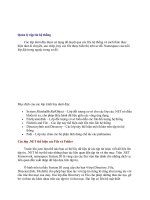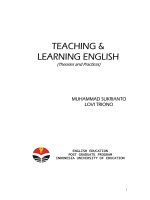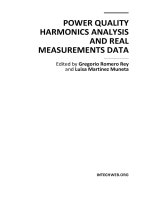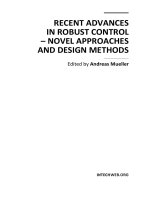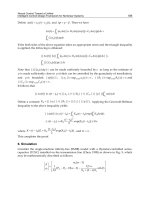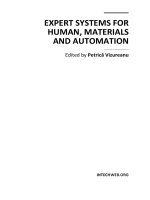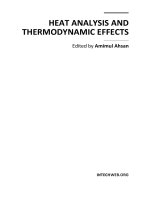Wind_Farm Technical Regulations Potential Estimation and Siting Assessment Part 1 pdf
Bạn đang xem bản rút gọn của tài liệu. Xem và tải ngay bản đầy đủ của tài liệu tại đây (713.39 KB, 20 trang )
WIND FARM –
TECHNICAL REGULATIONS,
POTENTIAL ESTIMATION
AND SITING ASSESSMENT
Edited by Gastón Orlando Suvire
Wind Farm – Technical Regulations, Potential Estimation and Siting Assessment
Edited by Gastón Orlando Suvire
Published by InTech
Janeza Trdine 9, 51000 Rijeka, Croatia
Copyright © 2011 InTech
All chapters are Open Access articles distributed under the Creative Commons
Non Commercial Share Alike Attribution 3.0 license, which permits to copy,
distribute, transmit, and adapt the work in any medium, so long as the original
work is properly cited. After this work has been published by InTech, authors
have the right to republish it, in whole or part, in any publication of which they
are the author, and to make other personal use of the work. Any republication,
referencing or personal use of the work must explicitly identify the original source.
Statements and opinions expressed in the chapters are these of the individual contributors
and not necessarily those of the editors or publisher. No responsibility is accepted
for the accuracy of information contained in the published articles. The publisher
assumes no responsibility for any damage or injury to persons or property arising out
of the use of any materials, instructions, methods or ideas contained in the book.
Publishing Process Manager Romina Krebel
Technical Editor Teodora Smiljanic
Cover Designer Jan Hyrat
Image Copyright maggee, 2010. Used under license from Shutterstock.com
First published July, 2011
Printed in Croatia
A free online edition of this book is available at www.intechopen.com
Additional hard copies can be obtained from
Wind Farm – Technical Regulations, Potential Estimation and Siting Assessment,
Edited by Gastón Orlando Suvire
p. cm.
ISBN 978-953-307-483-2
free online editions of InTech
Books and Journals can be found at
www.intechopen.com
Contents
Preface IX
Part 1
Technical Regulations and
Costs of Wind Power Generation
1
Chapter 1
Technical and Regulatory Exigencies
for Grid Connection of Wind Generation 3
Marcelo Gustavo Molina and Juan Manuel Gimenez Alvarez
Chapter 2
O&M Cost Estimation & Feedback
of Operational Data 31
Tom Obdam, Henk Braam, René van de Pieterman
and Luc Rademakers
Chapter 3
Community Wind Power –
A Tipping Point Strategy for Driving Socio-Economic
Revitalization in Detroit and Southeast Michigan 65
Daniel Bral, Caisheng Wang and Chih-Ping Yeh
Part 2
Potential Estimation and Impact
on the Environment of Wind Farms
95
Chapter 4
Methodologies Used in the Extrapolation
of Wind Speed Data at Different Heights
and Its Impact in the Wind Energy Resource
Assessment in a Region 97
Francisco Bañuelos-Ruedas, César Ángeles Camacho
and Sebastián Rios-Marcuello
Chapter 5
Wind Energy Assessment
of the Sidi Daoud Wind Farm - Tunisia
F. Ben Amar and M. Elamouri
Chapter 6
Wind Farms and Their Impact
on the Environment 141
Vladimír Lapčík
115
VI
Contents
Part 3
Siting Assessment of Wind Farms
163
Chapter 7
Advanced Wind Resource Characterization and Stationarity
Analysis for Improved Wind Farm Siting 165
Scott Greene and Mark Morrissey
Chapter 8
Spatial Diversification of Wind Farms:
System Reliability and Private Incentives 175
Christopher M.Worley and Daniel T. Kaffine
Chapter 9
Geotechnical and Geophysical Studies for
Wind Farms in Earthquake Prone Areas 191
Ferhat Ozcep, Mehmet Guzel and Savas Karabulut
Chapter 10
A Holistic Approach for Wind Farm
Site Selection by FAHP 213
Ilhan Talinli, Emel Topuz, Egemen Aydin and Sibel B. Kabakcı
Preface
Wind power generation is considered as the most economic viable alternative within
the portfolio of renewable energy resources. Among their advantages are the large
number of potential sites for erection and the rapidly evolving technology with many
suppliers offering from the individual turbine set to even turnkey projects. The
disadvantages of wind energy include high capital costs and lack of controllability on
the discontinuous or intermittent resource. However, the evolution of wind power
generation is being produced with a very high growth rate at world level (around
30%). This growth, together with the foreseeable installation of many wind farms in a
near future, forces the utilities to evaluate diverse aspects of the integration of wind
power generation in the power systems.
This book addresses a wide variety of issues regarding the integration of wind farms
in power systems, from technical regulations to siting assessment. The book is the
results of contributions from many researchers worldwide. I hope that the book will
become a useful source of information and basis for discussion for the readers. I wish
to thank all chapter authors for their efforts and the quality of the material submitted.
The book contains 10 chapters divided into three parts, grouped by different themes.
The first part (Chapters 1 to 3) outlines aspects related to technical regulations and
costs of wind farms. In the second part (Chapters 4 to 6), the potential estimation and
the impact on the environment of wind energy project are presented. Finally, the third
part (Chapters 7 to 10) covers issues of the siting assessment of wind farms. A brief
description of each chapter is presented below.
In Chapter 1 of the book, a revision of wind generation is presented, including a brief
history of the wind energy developments, some remarks related to the modern wind
energy systems, a survey of modern structures of wind turbines, major wind turbine
concepts related to fixed and variable speed operation and control modes, and
technical and regulatory exigencies for the integration of wind generation into the
electrical grid, including a study of selected countries grid codes.
In Chapter 2, the whole approach of structured data collection, data analysis, and
O&M cost estimation with the goal of increasing the accuracy and decreasing the
uncertainties of O&M costs estimates is discussed.
X
Preface
Chapter 3 introduces the concept of Community Based Wind Power as a test bed
solution to couple electric power generation with social and community development
initiatives. The idea of this concept is to provide individuals within a community with
an alternative model for the provision of their electric energy as well as socioeconomic needs.
Chapter 4 is aimed at presenting the impact of various methods and models used for
extrapolating wind speed measurements and generate a relevant wind speed profile.
The results are compared against the real life wind speed readings. Wind resource
maps come as a plus factor.
In Chapter 5, a meteorological and energetic study of the Sidi Daoud wind power
station installed in Tunisia is presented. Based on the meteorological data recorded,
the wind potential of the Sidi Daoud site has been evaluated by the meteorological
method and the Weibull and Rayleigh analytical methods.
Chapter 6 summarizes author's experience with environmental impact assessment of
wind farms. The chapter deals with experience with environmental impacts of wind
farms and implementation of the environmental impact assessment process in the field
of wind power in the Czech Republic.
Chapter 7 discusses statistical methods to identify potential sites for wind power
projects, outlining the state of the art in understanding the wind resource, and
discussing the strengths and weaknesses of existing methods.
Chapter 8 develops a simple theoretical model to compare the optimal siting decisions
of individual wind developers versus the optimal siting decisions of system operators.
In Chapter 9, geotechnical and geophysical studies for wind farms in earthquake
prone areas are investigated.
Finally, Chapter 10 aims to apply the fuzzy analytic hierarchy process (FAHP) to find
priority sequence of alternatives and obtain the key success factors for the selection of
appropriate sites of wind farms.
Gastón O. Suvire
Instituto de Energía Eléctrica
Facultad de Ingeniería
Universidad Nacional de San Juan
Argentina
Part 1
Technical Regulations and
Costs of Wind Power Generation
1
Technical and Regulatory Exigencies for Grid
Connection of Wind Generation
Marcelo Gustavo Molina1 and Juan Manuel Gimenez Alvarez2
1CONICET,
2CONICET,
Instituto de Energía Eléctrica, Universidad Nacional de San Juan
Depto. de Ingeniería Electromecánica, Universidad Nacional de San Juan
Argentina
1. Introduction
Pollution problems such as the greenhouse effect as well as the high value and volatility of
fuel prices have forced and accelerated the development and use of renewable energy
sources. In the three last decades, the level of penetration of renewable energy sources has
undergone an important growth in several countries, mainly in the USA and Europe, where
levels of 20% have been reached. Main technologies of renewable energies include wind,
hydraulic, solar (photovoltaic and thermal), biofuels (liquid biodiesel, biomass, biogas), and
geothermal energy. Within this great variety of alternative energy sources, wind energy has
experienced a fast growth due to several advantages, such as costs, feasibility, abundance of
wind resources, maturity of the technology and shorter construction times (Ackermann,
2005). This trend is expected to be increased even more in the near future, sustained mainly
by the cost competitiveness of wind power technology and the development of new power
electronics technologies, new circuit topologies and control strategies (Guerrero et al., 2010).
However, there are some disadvantages for wind energy, as wind generation is
uncontrollably variable because of the intermittency of the primary resource, i.e. the wind.
Another important disadvantage is that the best places to install a wind farm, due to the
certainty and intensities of suitable wind, are located in remote areas. This aspect requires of
additional infrastructure to convey the generated power to the demand centres.
Unfortunately, in several countries the regulatory aspect does not follow this fast growth of
wind possibilities. Many countries do not have specific rules for wind generators and others
do not make the necessary operating studies before installing a wind farm (Heier, 2006).
Power system operators must consider the availability of these power plants which are not
dispatchable and are not accessible all the time. Today, developing countries, such as
Argentina, are subjected to an analogous situation with wind energy, having perhaps one of
the best sources of such energy around the world. Nowadays, there are several operative
wind farms and others in stage of building and planning. Similar to other countries, in
Argentina there is a lack of regulatory aspects related to this topic (Labriola, 2007).
This chapter thoroughly presents a revision of wind generation, including the following
sections. In the first part, a brief history of the wind energy developments is presented.
Following, some remarks related to the modern wind energy systems are made. Then, a
survey of modern structures of wind turbines is carried out, including towers and
foundations, rotor, nacelle with drive train and other equipment, control systems, etc.
4
Wind Farm – Technical Regulations, Potential Estimation and Siting Assessment
Subsequently, major wind turbine concepts related to fixed and variable speed operation
and control modes are described. Eventually, technical and regulatory exigencies for the
integration of wind generation into the electrical grid are discussed in detail, including a
study of selected countries grid codes.
2. Overview of wind energy technology
2.1 A brief history of wind energy development
Since ancient times, man has harnessed the power of the wind for a variety of tasks. Indeed,
humans have been using wind energy in their daily work for some 4 000 years. In 1700 B.C.,
King Hammurabi of Babylon used wind powered scoops to irrigate Mesopotamia. Some
other civilizations, like the Persians (500–900 A.D.), used the wind to grind grain into flour,
while others used the wind to transport armies and goods across oceans and rivers. Sails
revolutionized seafaring, which no longer had to be done with muscle power. More
recently, mankind has used the power of the wind to pump water and produce electricity.
So the idea of using wind, a natural source, is not new (Rahman, 2003).
The discovery of electricity generated using wind power dates back to the end of last
century and has encountered many ups and downs in its more than 100 year history. In the
beginning, the primary motivation for essentially all the researches on wind power
generation was to reinforce the mechanization of agriculture through locally-made
electricity generation. Nevertheless, with the electrification of industrialized countries, the
role of wind power was drastically reduced, as it could not compete with the fossil fuel-fired
power stations. This conventional generation showed to be by far more competitive in
providing electric power on a large scale than any other renewable one.
Lack of fossil fuels during World War I and soon afterward during World War II created a
consciousness of the great dependence on fossil fuels and gave a renewed attention to
renewable energies and particularly to wind power. Although this concern did not extend
for a long time. The prices for electricity generated via wind power were still not
competitive and politically nuclear power gained more attention and hence more research
and development funds. It took two oil crises in the 1970s with supply problems and price
fluctuations on fossil fuels before wind power once again was placed on the agenda. And
they were these issues confronting many countries in the seventies which started a new
stage for wind power and motivated the development of a global industry which today is
characterized by relatively few but very large wind turbine manufacturers (Vestergaard
et al., 2004).
Wind turbines that generate electricity today are new and innovative. Their successful
history began with a few technical innovations, such as the use of synthetic materials to
build rotor blades, and continued with developments in the field of aerodynamics,
mechanical/electrical engineering, control technology, and electronics provide the technical
basis for wind turbines commonly used today. Since 1980, wind power has been the fastest
growing energy technology in the world.
2.2 Modern wind energy systems
The beginning of modern wind turbine development was in 1957, marked by the Danish
engineer Johannes Juul and his pioneer work at a power utility (SEAS at Gedser coast in the
Southern part of Denmark). His R&D effort formed the basis for the design of a modern AC
wind turbine – the well-known Gedser machine which was successfully installed in 1959.
Technical and Regulatory Exigencies for Grid Connection of Wind Generation
5
With its 200kW capacity, the Gedser wind turbine was the largest of its kind in the world at
that time and it was in operation for 11 years without maintenance. The robust Gedser wind
turbine was a technological innovation as it became the hall mark of modern design of wind
turbines with three wings, tip brakes, self-regulating and an asynchronous motor as
generator. Foreign engineers named the Gedser wind turbine as ‘The Danish Concept’
(Chen & Blaabjerg, 2009).
Since then, the main aerodynamic concept has been this horizontal axis, three-bladed,
upwind wind turbine connected to a three-phase electric grid, although many other
different concepts have been developed and tested over the world with dissimilar results.
An example of other concepts is the vertical axis wind turbine design by Darrieus, which
provides a different mix of design tradeoffs from the conventional horizontal-axis wind
turbine. The vertical orientation accepts wind from any direction with no need for
adjustments, and the heavy generator and gearbox equipment can rest on the ground
instead of on top of the tower (Molina & Mercado 2011).
The aim of wind turbine systems development is to continuously increase output power.
Since the rated output power of production-type units reached 200 kW various decades ago,
by 1999 the average output power of new installations climbed to 600 kW. Today, the
manufactured turbines for onshore applications are specified to deliver 2-3 MW output
power. In this sense, the world’s first wind park with novel ”multi-mega power class”
7 MW wind turbines was manufactured by the German wind turbine producer Enercon (11
E-126 units) and put into partial operation in Estinnes, Belgium, in 2010 (to be completed by
July 2012). The key objective of this 77 MW pilot project is to introduce a new power class of
large-scale wind energy converters (7 MW WECs) into the market with potential to
significantly contribute to higher market penetration levels for wind electricity, especially in
Europe. On the other hand, sea-based wind farms are likely to mean bigger turbines than on
land, with models that produce up to three times power of standard on-shore models. Series
production of offshore wind turbines can reach to date up to 5 MW or more, being the
largest onshore wind turbine presently under development a 10 MW unit. At least four
companies are working on the development of this “giant power class” 10 MW turbine for
sea-based applications, namely American Superconductors (U.S.), Wind Power (U.K.),
Clipper Windpower (U.K.) and Sway (Norway). Even more, it is likely that in the near
future, power rating of wind turbines will increase further, especially for large-scale
offshore floating wind turbine applications.
3. Structure of modern wind turbines
Basically, a wind energy conversion system consists of a turbine tower which carries the
nacelle, and the wind turbine rotor, consisting of rotor blades and hub. Most modern wind
turbines are horizontal-axis wind turbines (HAWTs) with three rotor blades usually placed
upwind of the tower and the nacelle, as illustrated in Fig. 1 (Molina & Mercado, 2011). On
the outside, the nacelle is usually equipped with anemometers and a wind vane to measure
the wind speed and direction, as well as with aviation lights. The nacelle contains the key
components of the wind turbine, i.e. the gearbox, mechanical brake, electrical generator,
control systems, yaw drive, etc. The wind turbines are not only installed dispersedly on
land, but also combined as wind farms (or parks) with capacities of hundreds MWs which
are comparable with modern power generator units.
6
Wind Farm – Technical Regulations, Potential Estimation and Siting Assessment
Fig. 1. Major components of a typical horizontal axis, three-bladed, upwind wind turbine
Of the various wind turbine models found around the world, most operate in a similar way
and have components that serve very similar functions. Based on this feature, major
components that most wind turbines have in common are described below.
3.1 Tower and foundation
One of the most important pieces of the wind turbine assembly is the tower that it is
mounted upon. Mounting a wind turbine on the highest possible tower results in increased
power production due to the stronger winds present at higher altitudes. In addition, the
effects of the wind shear caused by the surrounding terrain is also much less at higher
altitudes, providing yet another reason to mount the turbine as high as possible.
Of course, there are some limitations as to how tall of a tower is appropriate for a given
application. One such consideration is the structural requirement necessary to support the
turbine being considered, included how much the turbine weighs as well as what types of
environmental forces (high winds, snow, rain) it will have to sustain over time. Zoning
regulations may also play a role in dictating the maximum allowable height that the turbine
assembly may be elevated off the ground (Villalobos Jara, 2009).
There are many different types of towers available for a wide variety of turbine sizes. One of
the primary categories is the Lattice Tower which is essentially a very narrow, pyramid
shaped structure that is strengthened with trusses. Towers of this variety may be selfsupporting or they can be further supported by wires.
The other predominant type of tower is the monopole tower. This type of tower consists of a
single pole that supports the turbine. As it is expected, lattice towers are much sturdier and
can therefore elevate wind turbines to much greater heights than the monopole tower.
However, the lattice towers also require more ground space for their larger footprint than
what is necessary for a monopole tower. As a result, there is seemingly a tradeoff between
strength and the amount of land consumed by the tower foundation. This was true up until
Technical and Regulatory Exigencies for Grid Connection of Wind Generation
7
the advent of the now traditional tube tower. As strong, if not stronger, than a lattice tower,
the tube tower takes up not much more land than a monopole tower. Due to its immense
foundation, located almost entirely underground, tube towers are extremely sturdy
structures that can withstand the strongest forces. While not possible until today’s modern
manufacturing and engineering practices, tube towers have engulfed the entire wind
industry and it is rare to see a turbine of any appreciable size erected that is not sited on a
tube tower.
The design of the wind turbine foundation in order to guarantee its stability at all operating
conditions depends not only of the consistency of the underlying ground but also of the
changing weather conditions (e.g. expanse and depth of permafrost in polar regions and
where ice is prevalent) to support weight, plus huge static loads and variable forces exerted
by the rotating turbine is extremely challenging. Tower foundations must not settle, tilt or
be uplifted. Pile foundations may extend 1/3 to 2/3 the height of the tower into the ground.
This requires thorough geotechnical research and testing to assess the ground conditions at
the site to determine foundation design recommendations.
Offshore wind turbine foundation design requires development of highly cost effective
concepts, because the share of the cost of the foundation relative to that of the complete
wind turbine installation is considerably higher than that of an onshore foundation. Further,
environmental and energy gain considerations require of wind farms to be located farther
from shore at consequently deeper waters (Villalobos Jara, 2009). With this trend of ever
larger turbines in deeper and rougher waters, the design and construction challenges and
complexity increase proportionally, and both become closer to or beyond normal
experience. Hence, value engineering becomes crucial for development of foundation
concepts that are sufficiently robust to be carried through to site installation without
impacting the economic viability of the projects.
3.2 Rotor
The rotor is the heart of a wind turbine and consists of multiple rotor blades attached to a
hub. It is the turbine component responsible for collecting the energy present in the wind
and transforming this energy into mechanical motion. As the overall diameter of the rotor
design increases, the amount of energy that the rotor can extract from the wind increases as
well. Therefore, turbines are often designed around a certain diameter rotor and the
predicted energy that can be drawn from the wind.
The predominant aerodynamic principles that rotor designs are based upon are Drag Design
and Lift Design. Drag design rotors operate on the idea of the wind “pushing” the blades
out of the way, thereby setting the rotor into motion. Drag design rotors have slower
rotational speeds but high-torque capabilities, making them ideal for pumping applications.
With Lift design rotors, the blades are designed to function like the wing of an airplane.
Each blade is designed as an airfoil, creating lift as the wind moves past the blades. The
airfoil operates on the basis of Bernoulli’s Principle where the shape of the blade causes a
pressure differential between its upper and lower surfaces. This disparity in pressure causes
an upward force that lifts the airfoil. In this case, this lift causes the rotor to rotate, once
again transforming the energy in the wind into mechanical motion.
In the following, the structure and operation of rotors are discussed and concepts of power
control presented (Freris, 1990; Stiesdal, 1999; Thomsen et al., 2007).
8
Wind Farm – Technical Regulations, Potential Estimation and Siting Assessment
3.2.1 Rotor blades
Rotor blades are a crucial and basic part of a wind turbine. The design of the individual
blades also affects the overall design of the rotor. Various strains are placed on them, and
they must withstand very big loads. Rotor blades take the energy out of the wind; they
“capture” the wind and convert its kinetic energy into the rotation of the hub. The profile is
similar to that of airplane wings. Rotor blades utilize the same “lift” principle: below the
wing, the stream of air produces overpressure; above the wing, the stream of air produces
vacuum. These forces make the rotor rotate. Today, most rotors have three blades, a
horizontal axis, and a diameter of between 40 and 90 meters. In addition to the currently
popular three-blade rotor, two-blade rotors are also used to be common in addition to rotors
with many blades, such as the traditional wind mills with 20 to 30 metal blades that pump
water. Over time, it was found that three-blade rotor is the most efficient for power
generation by large wind turbines.
In addition, the use of three rotor blades allows for a better distribution of mass, which
makes rotation smoother and also provides for a “calmer” appearance. The rotor blades
mainly consist of synthetic materials reinforced with fiberglass and carbon fibers. The layers
are usually glued together with epoxy resin. Wood, wood epoxy and wood-fiber-epoxy
compounds are less widely used. One of the main benefits of wooden rotor blades is that
they can be recycled. Aluminum and steel alloys are heavier and suffer from material
fatigue. These materials are therefore generally only used for very small wind turbines. Each
manufacturer has its own rotor blade concepts and conducts research on innovative designs.
In general, though, all rotor blades are constructed similarly to airplane wings.
3.2.2 Hub
The hub is the centre of the rotor to which the rotor blades are attached. Cast iron or cast
steel is most often used. The hub directs the energy from the rotor blades on to the
generator. If the wind turbines have a gearbox, the hub is connected to the slowly rotating
gearbox shaft, converting the energy from the wind into rotation energy. If the turbine has a
direct drive, the hub passes the energy directly on to the generator. The rotor blade can be
attached to the hub in various ways: either in a fixed position, with an articulation, or as a
pendulum. The latter is a special version of the two-blade rotor, which swings as a
pendulum anchored to the hub. Most manufacturers nowadays use a fixed hub. It has
proved to be sturdy, reduces the number of movable components that can fail, and is
relatively easy to build.
3.2.3 Power control of the wind turbine
Wind turbines are generally designed to yield maximum power (nominal capacity) at a
rated (or nominal) wind speed in the range of 11–15 m/s (around 40–54 km/h, or nearly 25–
34 mph) for most commercial units. It does not justify designing turbines that maximize
their output at stronger winds, because such strong winds are rare.
In case of stronger winds it is necessary to waste part of the excess energy of the wind in
order to ensure that a maximum constant level of power is fed to the grid and thus avoids
damaging the wind turbine.
Wind turbines begin generating power at the cut-on speed of around 2.5–4 m/s (about 9–
14 km/h, or almost 6–9 mph) and cut off at wind speed of 25-34 m/s (around 90–122 km/h,
or nearly 56–76 mph). The maximum wind speed (or survival speed), above which wind
